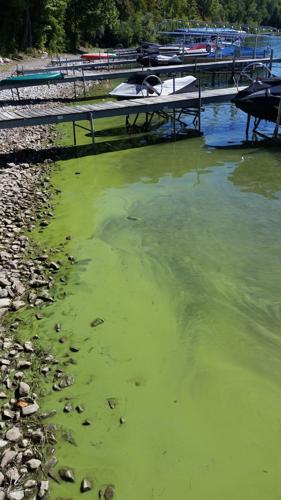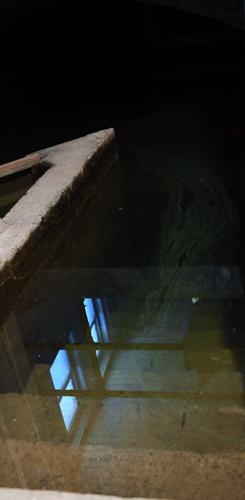The cost of installing blue-green algae toxin treatments to the city of Auburn's plant will likely cost between $1.5 million and $15 million, city and Cayuga County leaders learned on Monday.
Seth Jensen, director of Municipal Utilities for Auburn, said GHD Consulting Services Inc. met with local officials to go over preliminary results of the water treatment plant's engineering study. While GHD is still waiting on a set of tests to verify initial results, the firm outlined ballpark costs for three options the city has been closely considering —
The hope, Jensen said, is to choose one or a combination of those treatment methods to rid the treated drinking water of microcystin, a toxin that can be released from blue-green algae or cyanobacteria. Eleven times last year, of more than 45,000 Cayuga County residents.
People are also reading…
The use of powder activated carbon, Jensen said, is expected to cost between $1.5 million and $5 million. The cost of using ozone ranges from $4 million to $6 million. And the cost of extending the intake pipe is projected to cost $15 million.Â

Blue-green algae floats into the slow sand filter at the city of Auburn's water treatment plant.
"That's a tough one," Jensen said about extending the intake pipe. "That a big, big number to have to try and absorb, even if you are a large public utility, which we are not. That's a huge cost."
The entire projected cost list is sobering, especially after Gov. Andrew Cuomo announced in January that There has been no determination yet on how those funds could be split between the two plants, though there has been discussion about upgrading Auburn's plant to provide water to those residents served by Owasco during algae season. Jensen said if the city decides to seriously consider extending the intake pipe, they'd also likely partner with Owasco.
"It's just unfortunate that these costs are as high as they are for a one-month-out-of-the-year treatment," Jensen added.
Powder activated carbon is something the city already began using last summer when they discovered the paint-like scum floating into the plant. But GHD has consulted with experts in Toledo, Ohio, and Australia, where blue-green algae has plagued public water supplies. With their input, GHD has pinpointed specific kinds of powder activated carbon that have proven more effective at removing microcystin.Â
The wide cost range of $1.5 million and $5 million is due to the carbon byproduct, Jensen said. When the carbon is added to the water, it binds itself to the various particles and eventually settles out of the water as a kind of silt. That will likely need to be treated before its removal and disposal, and that could get expensive, Jensen said. Based on materials' cost alone, too, powder activated carbon is more expensive than ozone, he added.
"There's definitely ancillary benefits to powder activated carbon," Jensen said. "It's about the same time each year we're dealing with complaints from the public about the taste and odor, largely because there's blue-green algae in the water, whether it's harmful or not. It gives an earthy taste people don't like. (The carbon) helps to mitigate it. To some extent, that's a two birds, one stone approach."
Using the disinfectant, ozone, is going to be trickier. Jensen said the timeline to install an ozone system will be nearly impossible to meet before this summer. While there are batch machines that can hook up temporarily, Jensen said specs still need to be worked out.Â
GHD has also recommended the city consider potassium permanganate, something that it had not considered closely before. Also an oxidizer like ozone and chlorine, the potassium could be added at the plant's intake pipe. It would only remove microcystin and not the algae itself. Jensen said the main concern with using that treatment method is that if too much is used, the oxidant can turn the water purple. Jensen said the city used to use potassium permanganate at its intake pipe in the past, and at one point had used too much.
"We overdosed it at one point in time, and our filtration plant staff got many, many phone calls because they (customers) went to fill their bathtub with water, and it had a purple-ish tint to it," he said. "There are no health impacts, but obviously you don't want your water to be purple."
Still, it could help address the other problem lurking at the plant's intake pipe — zebra mussels. The city stopped using chlorine at the intake pipe, which was killing off the invasive species, because it was also killing the algae, thereby releasing microcystin. And if that weren't enough to worry about, Jensen said, experts in Toledo recommended considering a multi-pronged treatment process in case other toxins besides microcystin crop up.Â
Scientists are still grappling with what makes an algae bloom toxic, and what makes it have certain toxins over others. Microcystin, a liver toxin, has been one of the most common detected in Owasco Lake's blue-green algae blooms, but experts in Toledo warned that officials should test and prepare for saxitoxins. According to the Centers for Disease Control and Prevention, saxitoxins can cause gastrointestinal and neurological issues including nausea, headache, vertigo and cranial nerve disfunction. The CDC also says the toxin can be lethal through paralysis.
Jensen said saxitoxins have not been detected in Owasco Lake's water, but it's something they are taking into consideration.
"We don't want to necessarily design around one specific toxin if there are emerging toxins out there," he said.
While no decisions were made on Monday as to which treatment methods to use, Jensen said GHD will present its findings at the Auburn City Council meeting on Feb. 9. He hopes the city will have a better idea then about how to move forward. Meanwhile, he added, the plant has more information from GHD's study about what it can do in its existing facility to enhance toxin removal.
"I'm still hopeful, though, that we'll be able to have some sort of plan implemented that will effectively treat microcystin in the short-term, and if there is the need for a long-term solution, it might just take a year or two to fully develop," Jensen said. "We'll coordinate those together to get our final goal of being able to remove microcystin."
Staff writer Gwendolyn Craig can be reached at (315) 282-2237 or gwendolyn.craig@lee.net. Follow her on Twitter @gwendolynnn1.
































